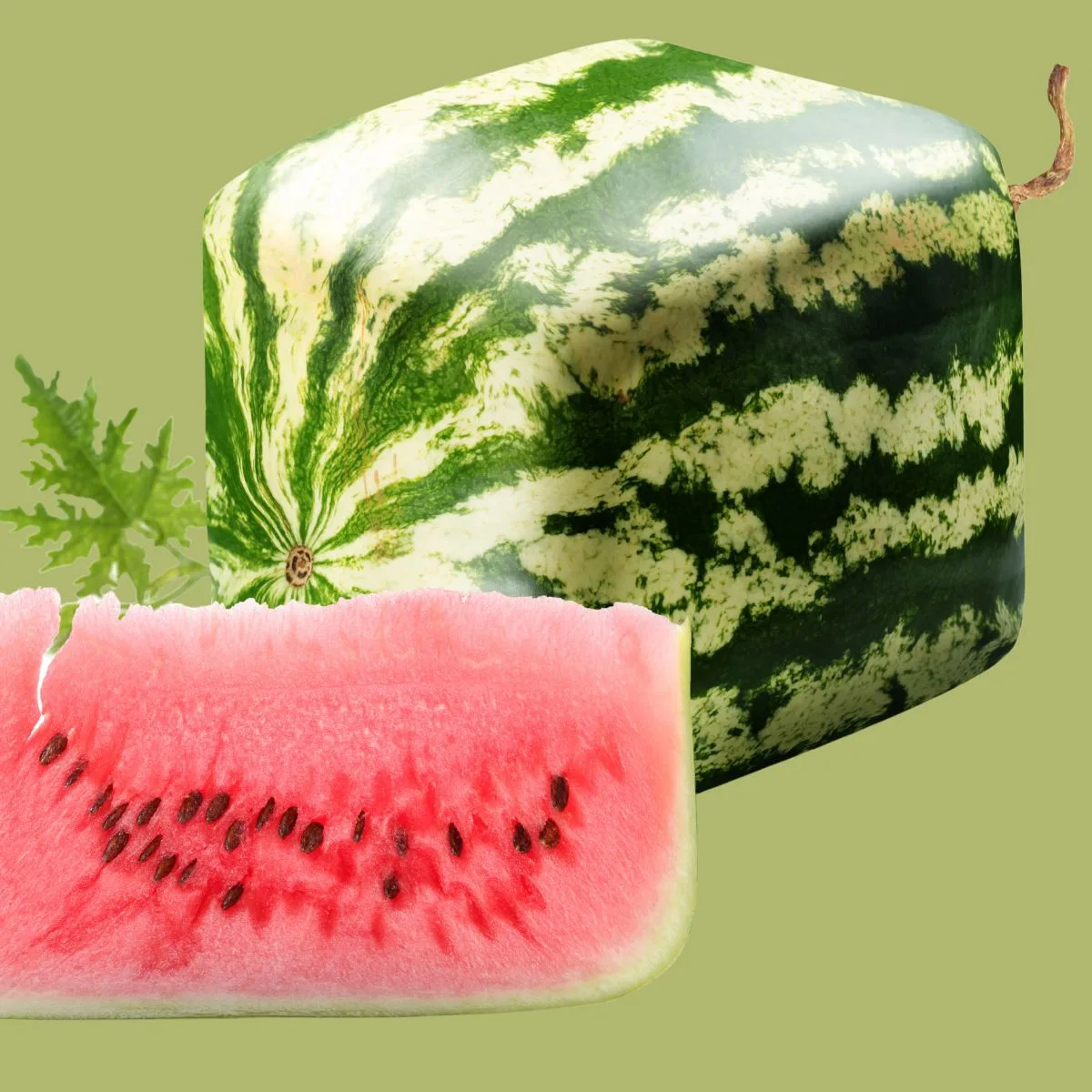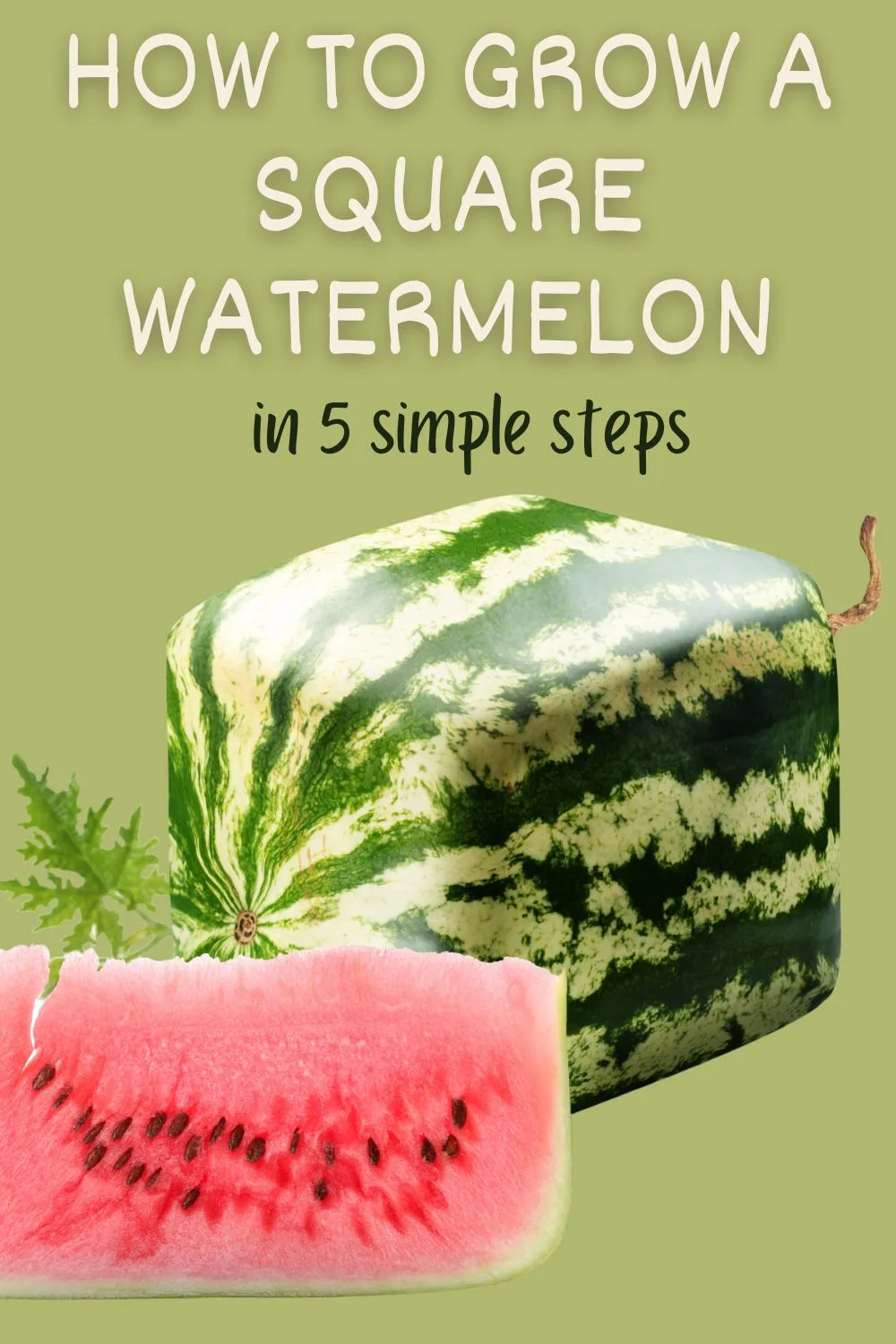For a unique twist on regular watermelons, try growing square watermelons! These unusual fruits are eye-catching and perfect for your summer parties or farm stand. Fortunately, you can learn how to grow a square watermelon in your backyard with some knowledge and the right tools.

What Are Square Watermelons?
Cube-shaped watermelons started in the 1960s when Japanese farmers1 in the Kagawa prefecture wanted to find a way to make their watermelon crop more profitable.
One local farmer molded his watermelon fruits to grow in a specific shape. Soon, many farmers started enclosing the regular watermelons in a clear square box, making them into perfect cubes.
Sadly, shaping the melons into squares took a lot of effort and would not be profitable if they were sold ripe (since you needed to use them immediately, and no one would pay the price). Eventually, farmers started harvesting the square-shaped melons before they ripened to preserve them longer. So, these days, cube-shaped watermelons are grown to admire, not to eat. They’re labeled explicitly as ornamental fruits since they are typically harvested before they are fully ripe.
Why Grow Square Watermelons?
Should you bother growing your square watermelon since they aren’t developed for eating? Absolutely! Here’s why:
- Fun with kids: get the kids interested in gardening by involving them in growing these unusually shaped watermelons. They will learn much about how fruits and vegetables form and grow during their life cycle. Plus, it’s fun to see the round melon turn into a unique shape! Here are more garden activities for kids.
- Novelty factor: Square watermelons are eye-catching and would be a fun addition to any party.
- Unique crop to sell: These expensive fruits are hard to find outside Japan. Grow your own to expand your farm business.
How to Grow a Square Watermelon
No matter what shape of watermelon you choose to grow, the process is similar to growing traditional round watermelons. You’ll need to sacrifice a plant and remove all shoots after the first melon develops so that the plant will focus on just one fruit.
1. Choose the right seeds
Choose seeds for your growing zone. Watermelons typically require a long growing season, but people in cooler climates with shorter seasons can successfully grow square watermelons with an early ripening variety.
To grow square watermelons, look for seeds for smaller varieties that can grow well in your climate. For example, Sugar Baby or Yellow Petite naturally ripens at a smaller size, making it much more likely for your square melons to mature so you can eat them (instead of just admiring them for their unique appearance).
2. Start seeds indoors
Square watermelon seeds should be started indoors about six to eight weeks before the last frost date in your area. Plant each seed in a separate container filled with moist potting soil. Keep the containers in a warm, sunny location and water regularly.
3. Transplant Seedlings
Once the young seedlings have developed their first set of true leaves and the soil temperature reaches 60 degrees F, transplant them into the ground.
Harden the watermelon seedlings off by gradually bringing them outdoors to get used to wind and warm temperatures for 4-5 days. Once the watermelon plants can tolerate being outdoors overnight, transplant them into the soil.
Watermelon prefers sandy loam soil, and they will need plenty of space (15-20 square feet per plant), so be sure to choose an appropriate spot in your garden. Consider installing drip irrigation for consistent watering and the most uniform watermelon fruits.
4. Add the square container
First, your watermelon plants need to grow. Once your plants form baby melons, open the square mold and place the bottom of the melon at the bottom of the case. Close the glass box and position it securely on the ground. I looked for a square-shaped mold on Amazon, and sadly, I didn’t find one. Maybe you can find one in a local store, but if not, I’d use a square plastic container. (like this one).
To focus the plant’s attention on this one special melon, you’ll want to remove any side shoots that appear along the main vine. Continue caring for the plants like normal, watering regularly, and weeding to remove any competitor plants.
5. Harvesting
Square watermelons can take longer to mature than traditional round watermelons, so be patient. Make sure the melon has filled the mold. Once the fruit is fully mature, it should be a perfect square shape. Cut the fruit from the vine and store it in a cool, dry place until you’re ready to enjoy it.
How Do You Know When To Harvest Watermelon?
There are a few tell-tale signs to indicate when you have a ripe watermelon.
- Look at the shininess of the flesh. As the melons ripen, the skin takes on a dull appearance.
- Examine the bottom of the melon. If it has a cream or yellow spot, it’s likely ripe.
- Knock on the melon: if you hear a dull thud, it’s ripe.
Other Watermelon Shapes To Try
Once you start with the box design, you’ll realize how fun and easy it is to grow melons in different shapes.
Heart-shaped
Heart-shaped watermelons can be grown using a special mold that shapes the fruit as it grows. These molds can be purchased online or at specialty gardening stores.

Pyramid-shaped
Pyramid-shaped watermelons are also grown using a mold. These are some of the most popular shapes in Japanese stores.
Skull – Although commonly used to shape pumpkins, you can also form your watermelon into a skull.
Don’t be shy if you’ve been on the fence about growing your uniquely shaped watermelons! You’ll quickly realize how much fun it is and want to try molding other fruits and vegetables, too. Choose a design and
Other Vegetables You Can Grow Into Shapes
Watermelons aren’t the only fruit to be moldable. Here are a few other vegetables most of us grow that you could shape for fun with your kids:
- cucumbers
- zucchini
- pumpkins
- eggplants
You can also experiment with bell peppers, tomatoes, carrots, radishes, and beets, though these might be harder to work with. But you’ll for sure have a lot of fun!
Resources:
1. Learn more about how Japanese farmers started this trend of square-shaped melons.

Adriana Copaceanu is a passionate nature lover living in the country on her dream property where she grows vegetables, lavender, and wildflowers that she shares with the wildlife they attract. When she's not in the garden, she loves spending time with her chickens and planning her next nature project. Check out her books below:
How to Grow Lavender for Fun and Profit: Lessons Learned from Planting Three Hundred Lavender Plants


5 Easy Gardening Activities For Kids
Monday 22nd of May 2023
[…] Here’s a fun gardening project to do with the kids: grow square watermelons. […]